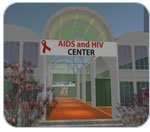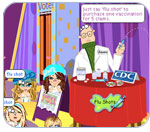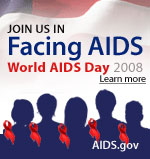We Are Living in a Virtual World: Part 1
When the AIDS.gov team first started hearing about virtual worlds, we were intrigued--and a little confused. Terms like “avatar  ” and “in-world meetings” were unfamiliar. Places like Second Life
” and “in-world meetings” were unfamiliar. Places like Second Life  , Whyville
, Whyville  , Club Penguin
, Club Penguin  , and Habbo
, and Habbo  seemed mysterious.
seemed mysterious.

HealthInfo Island on Second Life
NIH, CDC, and NASA have been Federal pioneers in virtual space. To learn more, we spoke to Erin Edgerton at the CDC; Andrew Hoppin, from CoLab at NASA; and Lori Bell and Carol Perryman from HealthInfo Island on Second Life--an NIH-funded project.
Our colleagues told us that virtual worlds are computer-based simulated environments  where you create your own character--or avatar.
where you create your own character--or avatar.
Virtual worlds look and feel like playing a video game, but unlike a video game, you don’t win or lose. They’re places you inhabit and interact with others.
Participation in virtual worlds is increasing at an average of 15 percent per month, according to the Gartner Group  . By 2011, they estimate that 80 percent of Internet users will take part in virtual worlds.
. By 2011, they estimate that 80 percent of Internet users will take part in virtual worlds.
How can we use virtual worlds to improve public health?

AIDS and HIV Center on Second Life
Virtual worlds can provide an immersive experience where users can get health information and practice healthy behaviors. Modeling good health behaviors in the virtual world can help turn these virtual activities into real-life behaviors.
Carol told us, “At NIH we discovered that consumer health information was one of the most important services we could provide in the virtual world. As more and more people of all ages use the Internet and spend increasing amounts of time online, we want to reach users where they are.” There are a number of medical agencies in Second Life, including professional organizations that are looking at it for training purposes, medical libraries, and support groups for people with medical problems (e.g., HIV/AIDS, Asperger’s Syndrome).
Andrew told us that NASA became interested in virtual worlds because they were looking for a space to collaborate with entrepreneurs, volunteers, and students. Once they began participating in Second Life, NASA discovered new uses for this virtual world: training, virtual prototyping, and building new partnerships. Andrew told us that, in a typical week, over 700 people visit NASA’s space in Second Life and spend approximately 650 hours per week interacting in the virtual NASA.

Virtual vaccinations in Whyville
For two consecutive years, CDC has worked with Whyville to promote virtual vaccinations for seasonal influenza. Erin told us the CDC selected Whyville to encourage flu vaccinations “because it focused on science and education, and because of its previous research on in-world vaccinations.” Whyville citizens had the opportunity to be virtually vaccinated--preventing them from catching the “Why-Flu,” which caused red spots to appear on avatars’ faces and made them sneeze while chatting. During the first six-week activity in 2006, almost 20,000 unique Whyvillians were vaccinated.
Virtual worlds, like Whyville, aren’t just for young people. When the CDC introduced the Why-Flu, for the second time, in November 2007, they created opportunities to engage people of different generations. Once Whyville members were vaccinated, they could send invitations to their grandparents, inviting them to be virtually vaccinated. This resulted in nearly 41,000 virtual vaccinations, and over 1,800 grandparents participated.
Another addition to the 2007 activity was a two-way information exchange between CDC subject-matter experts and Whyvillians. At an in-world vaccination party, kids and grandparents talked with a live CDC expert to get answers to health questions and learn more about the CDC.
Venturing Deeper into Virtual Worlds
On July 1, we’ll finish the second part of this two-part series on virtual worlds. For the next two weeks, however, we’ll be focusing our blog posts on National HIV Testing Day (June 27)  .
.
In the meantime, we encourage you to spend some time in a virtual world. It is easy to sign up for a free account in Second Life, Whyville, Club Penguin, or Habbo. Each offers a unique experience and the best way to learn about these worlds is to jump in!
Hope to see you there!




In June 2007 I joined Second Life and I saw the opportunity to ue this virtual world as a venue to increase HIV Awareness, So thanks to Fleep Tuque the owner of Chilbo Community Building Project for providing me a building in which to house the SL HIV Prevention and Education Center in Madhupak. Since that time I had over 100 visitors to the center and have expanded the center to include information on STI's and other Women Health issues. I have provided Risk Reduction Counseling to a few member of SL as well as Counseling to PLWH/A. In April 2008m,Ethan LeSabre (SL name)the manager of the AIDS Memorial Garden asked me to open the SL HIV Prevention and Education Annex which has been visited by at least 35 members of SL. Ethan and I are presently working on the developement of the Second Life HIV/AIDS Support Network Headquarters in Upadhyaya region. So, if you are a SL member or are planning to become a member please visit the sites mentioned above and drop me a note card and let me know what you think.
Posted by: Felicita ( Real Life name) Lizzette Zenovka (Second Life name) | June 19, 2008 at 08:03 PM
Its a pretty good idea to use virtual worlds for learning and even maybe virtual training in jobs etc soon. I assume its easily accepted since the generations up to those who are now in their 40's would have been part of the video game generations. Atari, Commodore 64, etc and that's one thing the video game generations have said at one time = " these video games just keep getting better, can you imagine what they'll be like in the future!" The video game generations expected the new technology to make it so that one day you play the video game from inside a virtual world. That technology has probably not explored even a remote percentage of what could be done, in my opinion.
http://www.ezprintsolutions.com
Posted by: EzPrintSolutions | July 10, 2008 at 10:33 AM